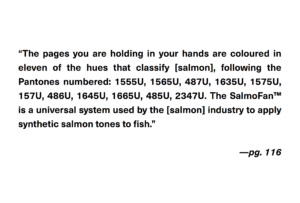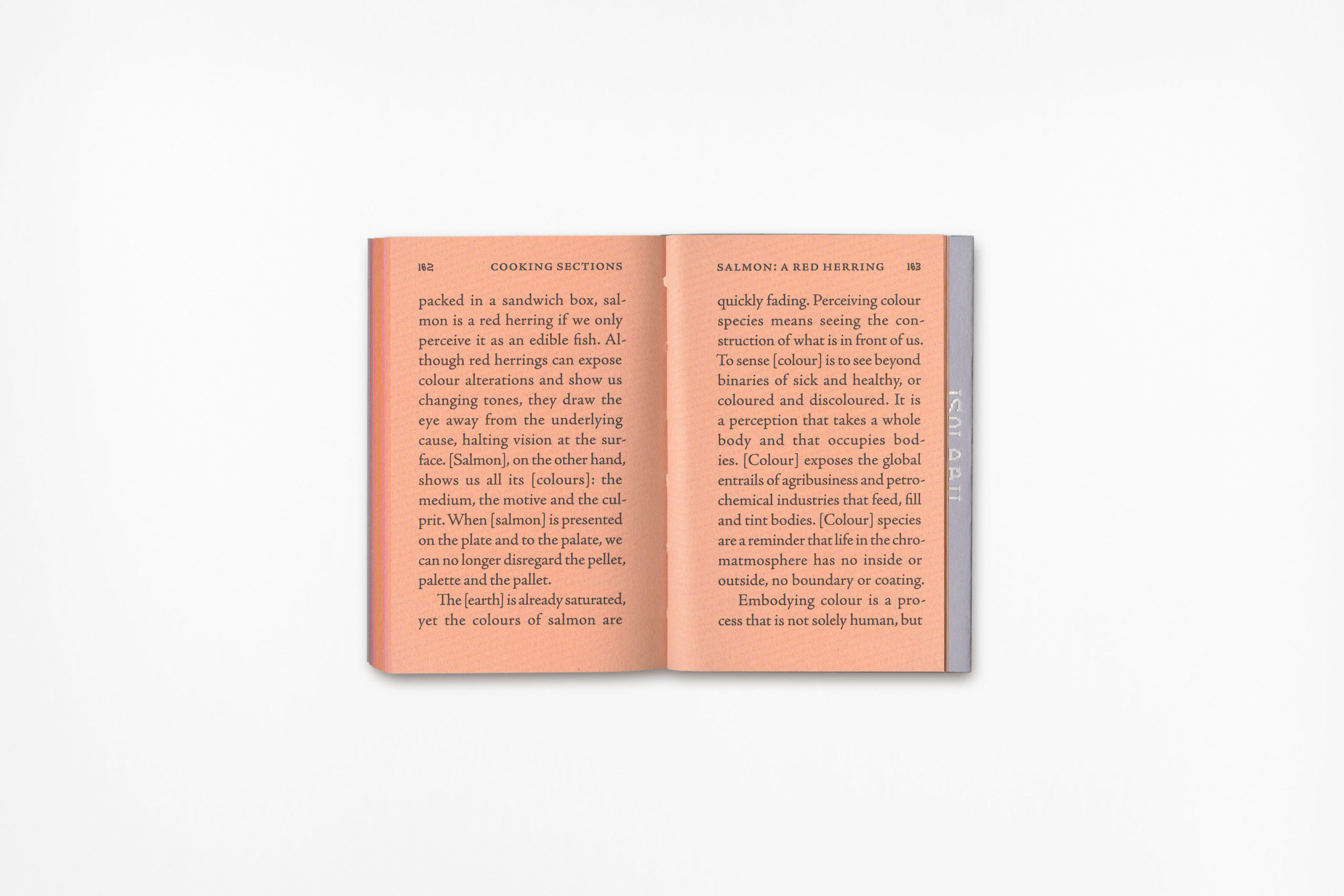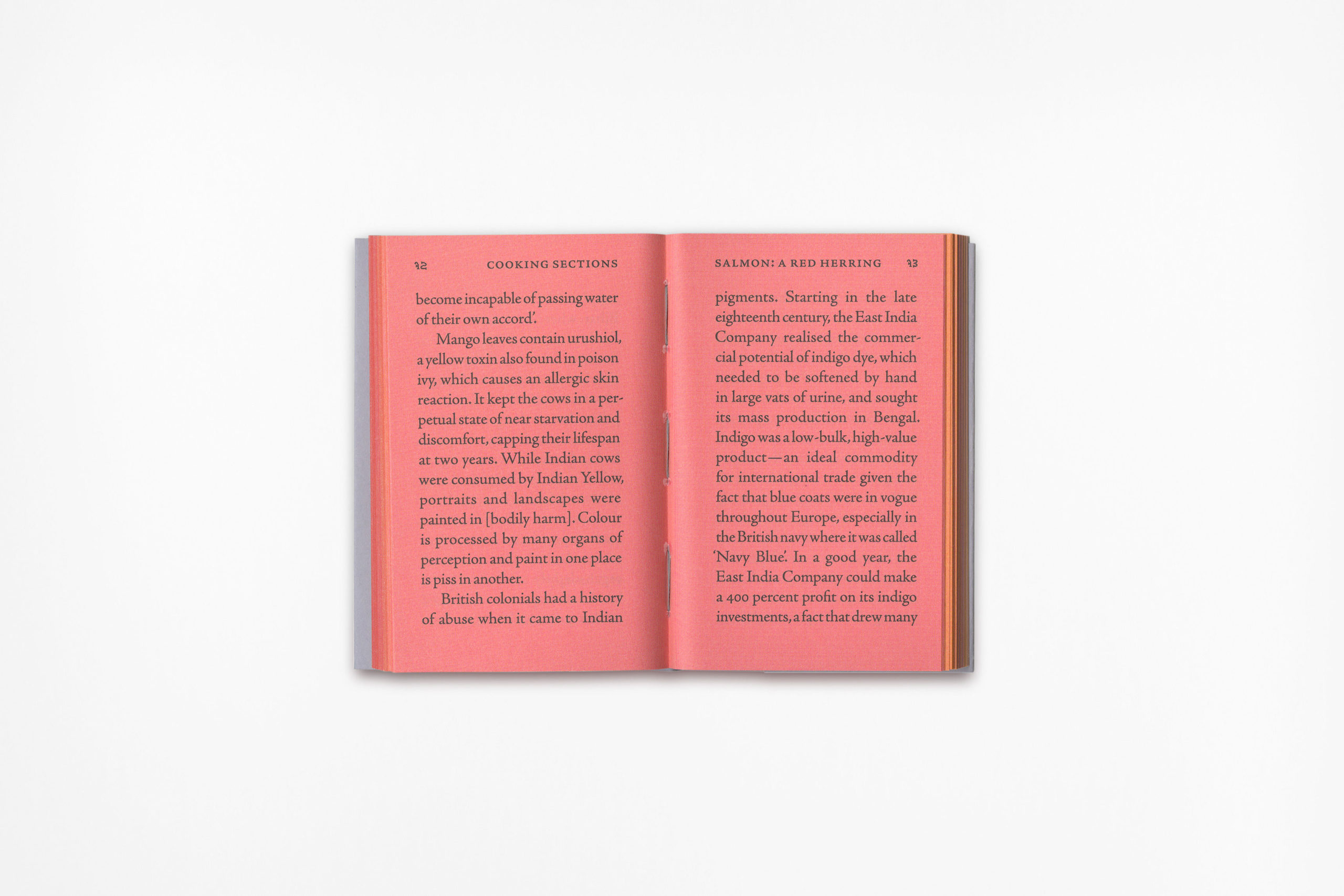How do you like your salmon?
If you prefer the natural look, that’s fine—there’s a choice of 15 official shades available. This is not a joke. According to Cooking Sections’ new book, Salmon: A Red Herring, our commonly held ideas about color and nature are based on some fundamental misconceptions and misperceptions.
Cooking Sections is the name of a duo of spatial practitioners consisting of Daniel Fernández Pascual (the 2020 recipient of the Harvard GSD Wheelwright Prize for his research project Being Shellfish: The Architecture of Intertidal Cohabitation) and Alon Schwabe. Adopting a multimedia, multi-discipline approach including installation, performance, mapping, and video, the London-based group explores “systems that organize the world through food” within the overlapping boundaries of architecture, visual culture, and ecology.

Salmon: A Red Herring takes salmon as a starting point to explore how the human desire to categorize nature into distinct, definable, and quantifiable components ignores nature’s very nature. It examines examples of “color leaks”—where nature impinges on our preordained, man-made perception of the world’s color scheme. The mass farming of salmon, for instance, has resulted in altering the diet that determines the fishes’ color—which then has to be artificially “fixed” to make it look palatable to us. According to Fernández Pascual and Schwabe, “An increasing amount of industrial energy is directed, therefore, toward dyeing the world in natural colors so that life and commerce may proceed.”
The result is a book that is hugely informative and hugely entertaining in equal measure. Are oranges orange? Is salmon salmon? Is nature natural? Cooking Sections will make you question everything you think you know—and leave you all the wiser for understanding that you know very little.
Oranges Are Orange, Salmon Are Salmon
By Cooking Sections
Oranges require orange to be. They are a color expectation. If an orange is not orange, it is no orange.
Oranges originated in China, where they were crossbred from a mandarin and a pomelo as early as 314 B.C. From there, oranges passed from Sanskrit नारङ्ग (nāran˙ga) through Persian نارنگ (nārang) and its Arabic derivative نارنج (nāranj). Traveling to continental Europe with the Moors, naranjas soon dotted al-Andalus and Sicily. Oranges arrived in England from France in the fourteenth century, their bright skins holding a taste of a color that became popular in markets, on palates, and, eventually, in tongue.
For centuries, oranges were orange and, still, orange was not a color—it was called yellow-red. It took another two hundred years for the color to earn its name, to become a form that could give itself to others—to be ascribed to flowers, stones, minerals, and the setting sun.
To the west, oranges followed the path of Spanish missionaries and lent their name to Orange County and the Orange State. In California, the fruit fed the miners of the gold rush who passed through mission towns. In Florida, there were so many groves that, by 1893, the state was producing five million boxes of fruit each year. In this tropical climate—nights too humid and too hot—oranges would ripen too quickly: they were ready to be eaten while still green. And so, from the twentieth century onward, green oranges have been synthetically dyed orange, coated to match consumer expectations. Orange reveals that humans cannot imagine a species detached from its color, even when we are the ones who detach it.
Amid all the observations that are made about industrialization and its consequences, the following is rarely heard: the world’s colors are shifting. From infancy, we describe, dream, and remember predominantly with our sense of sight, and there is no seeing without exploring, no static vision. We are raised to bend color to our will, at times admonishing it and elsewhere applying it to our liking. We grow up coloring in pictures of the world—trees are green, earth brown, and yolks yellow. That everything else in life is turned regularly upside down is only tolerable because oranges remain orange and the sky blue. An increasing amount of industrial energy is directed, therefore, toward dyeing the world in natural colors so that life and commerce may proceed.
But dyes may miss their mark. Shifting cues in flesh, scales, skin, leaves, wings, and feathers are clues to the environmental and metabolic metamorphoses around and inside us. The force that is color is not for domestication; it is fugitive. Color colors outside our lines.
*
In 2018, an eye-catching sparrow was spotted on the Isle of Skye. The sparrow was bright pink.
We know what sparrows are supposed to look like, because they have evolved with us. Over several millennia, food scraps from human settlements attracted sparrows from the “wild,” which caused them to mutate into a new species. “House” sparrows have since become a familiar sight wherever humans dwell, metabolizing the shades of our settlements into their brown-gray feathers. They are drabber than their older, tree sparrow cousins, who preserve the brighter tones of the forest.
The pink sparrow, neither forest nor house, was a color leak. The sparrow had turned [salmon].
On the Isle of Skye—whose name comes from the Gaelic for “winged”—colorful feathers lure eyes. Anglers, fishing for sport, carefully tie fish flies from synthetic rainbow plumage that resembles insects, enticing salmon. These iridescent wings are easy prey. Salmon bite on the colors that they find attractive, only to swallow a deadly hook.
In the nineteenth century, colonists in the tropics were drawn to exotic birds and sent them back to Britain. These startling hues and patterns inspired new recipes for salmon flies, and plucked feathers, far from their origins, were used to pluck salmon from their natal streams. A combination of toucans, peacocks, and macaws, the flies mimicked salmons’ cravings. Hued plumage was used to deceive: to confuse the edible and the deadly. Salmon, beings for whom the ingestion of color is essential, took the bait.

Salmon are at home in color. Whipping her tail, a female salmon spends two days making a depression in the riverbed called a redd—the word probably comes from the Early Scots ridden, meaning “to clear”—into which she deposits her roe. Fertilized, these red spheres of nutrients encase young salmon, who eat their way out, taking the color inside. Once the eggs are depleted, salmon swim to the ocean in search of food. There, they feed on red-pink crustaceans, mostly shrimp and krill, as well as small fish with even smaller crustaceans in their digestive systems. From these, they absorb yellow-red orange fat-soluble pigments, called carotenoids, that tint salmon salmon.
Crustaceans swimming at 63°29’19.8″ N, 10°21’55.7″ E might be redder than those at 56°52’01.7″ N, 6°51’00.6″ W, but pinker than those at 56°41’24.9″ N, 175°58’53.5″ W. Salmon record their location by metabolizing these shades—their flesh is color-coordinated. If salmon could peer inside their own bodies, they could distinguish, from their muscle tones, the Trondheim Fjord from the waters of Skye or the Bering Sea.
When salmon are ready to breed, they stop eating. Their stomachs shrink to the size of an olive, to make room for roe and milt, and they are drawn back to their birthplace, searching for home against the current. They follow what scientists suspect to be inherited maps encoded in their DNA, tracing chemical pathways and geomagnetic fields, which can lead them on journeys of more than three thousand kilometers.
Upon reaching fresh water, which bears murky river silt, salmon retinas trigger a biochemical switch that lets them see in infrared for clarity. Changes in sea temperature and water composition, in turn, activate memories of their original stream. Their senses act like a compass—not to determine the location of home, but rather the direction toward homecoming. Olfactory imprints allow salmon to swim through a smell-bank in their brain—what humans would think of as “remembering.” For salmon, this is perhaps not an active decision; it is an urge to return, to retrace innate memories homeward, extending to the moment of their birth.
The swim upstream requires such great exertion that it pushes red pigment to the surface of a salmon’s skin—a sign of health that lures mates. Female salmon pass on carotenoids in their flesh, to plump their roe and make it attractive to prospective males. Color streams through generations, linking salmon to their redd. Salmon color is the pathway—metabolic and geographic—of being; it is the atmosphere in which salmon are born and what they advertise when they spawn and die. Color in this cosmos, then, is more than cosmetic—it is a biological influence as strong as memory.
Salmon are a means by which color moves according to a logic of ingestion: salmon metabolize their color, drawing life from it, and humans, craving this color species, consume an image of health.
*
Such is the human thought of salmon: scales encasing ink-perfect pink flesh, a river leaping with fish on the run. A color bound to a body, a body bound to its own name.
On Skye, however, this pictorial logic is fading. Skye no longer runs salmon: populations have fallen to historic lows and corporate aquaculture has filled the waters around the island with intensive open-net salmon farms. Salmon—the color and the fish—is a red herring.
Open-net fish farms are flow-through feedlots, packed to the gills. Enclosed in pens with one to two hundred thousand other fish, a salmon cannot feed on krill and shrimp. Here, a salmon is naturally deprived of astaxanthin, the carotenoid that makes crustaceans pink and that protects a salmon’s body from solar radiation and stress. A salmon’s color reflects its well-being: darker pink salmon represents access to astaxanthin-rich crustaceans, whereas pale pink salmon represents a lack of nutrients or high stress levels. Farmed salmon, lacking these resources, are no longer truly salmon. Their flesh tone is now closer to white-gray than red. Salmon, the fish, are cleared of salmon, the color. Once they are gray, they are [salmon].
Salmon: A Red Herring is the August/September publication from isolarii, a series of books that articulates a new humanism. The book features forwards by Hannah Landecker, Bruno Latour, Hans Ulrich Obrist, and David Zilber.






